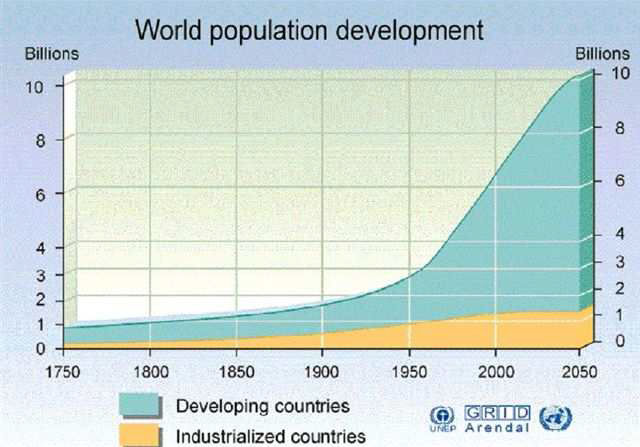Musings on the explosion. Continue reading →
Al Gore’s Oscar-winning film, An Inconvenient Truth made a strong case for immediate limits in the dispersal of greenhouse gases into the atmosphere. He demonstrated a strong need for action, and, by citing the successful reduction in the levels of aerosols that were destroying the ozone layer, he gave a pretty good indication that humanity was capable of implementing the necessary measures to solve this problem. This was, I think, a common impression among those watching his presentation.
However, in the audience in which I attended the screening I seemed to be one of the only people who was shocked by what he said near the end of the film. He showed the following graph as an indication of the context for decisions about climate change:
Notice that even though the projected growth rate is slightly less than the current rate, the population in 2050 will be four times what it was in 1950! This made a great impression on me. What good will it do, I thought, to start using more efficient light bulbs if there are four times as many of us who need the light? Furthermore, a very high percentage of the growth appears to be taking place in developing nations. Can we really expect people in those countries to use less energy in the future when they use so very little now?
The overwhelming impression that was made on my admittedly ignorant perspective was that considering the projected increase in carbon dioxide emissions as a cause of global warming made less sense than considering it as an effect of the population explosion that could have many dire consequences, one of which was catastrophic climatic disruption. Surely, at the least, nations should attack the “capita” part of “per capita emission” as vigorously as they attack the “emissions” part. In fact, Gore has changed his emphasis in this direction at least a little, as is evidenced by this piece.
There are, of course, two ways to limit the population growth rate: decrease the birth rate or increase the death rate. Massive wars and plagues might be used to implement the second approach, but nobody is arguing in their favor. So, as long as we are confined to the earth, we are pretty much stuck with decreasing the birth rate if we want to address the many problems caused by the excessive number of humans on our planet.
Analyzing the effect of birth rates is more complex than it may seem at first blush. The long-term objective of stabilizing population is achieved when, on the average, women produce one surviving daughter each. Thus, the replacement rate for developed countries, which have low infant mortality, is about 2.1. In the underdeveloped countries the replacement rate could be 3 or even more. Another important factor is the average age of the people. If the average age is low, then any decreases in the fertility rate will have a large effect in the long term, but in the near term, the population will still continue to grow at a startling rate. China, for example, has sustained a very low birth rate for a number of years, but the population has continued to grow because the number of young people at the time that the restrictive birth policies were implemented was enormous.
The list of birth rates by nation makes it quite clear that the African nations have by far the highest birth rates. Niger, with a fertility rate of over 7, is on top. Many developed countries in Europe and Asia have rates that are below the replacement rate. In general, the more developed the country the lower the rate. So, as Al Gore indicated, a primary strategy of population control should probably be the education of women in poorer countries so that they understand their choices better.
Don’t expect immediate results in Niger, however. Not only does it have the highest fertility rate in the world; it also boasts the lowest median age. Over half of all of its inhabitants are fifteen years old or less! Many of the other African nations with the highest birth rates also have median ages of twenty or less.
There is another strong factor, which is rather clearly indicated in this chart derived from the CIA’s “Factbook.” 
This graph shows the relationship between wealth (gross domestic product per capita on the horizontal axis) and birth rate (vertical axis) for large nations. The relationship is a rather smooth curve with only three outliers. Angola is probably a special case in that its wealth comes almost exclusively from recently exploited natural resources from which most citizens have benefited not at all. In fact, the literacy rate for women is barely 50 percent. So, from a development perspective Angola’s dot should probably be moved to the left.
The other two outliers are Saudia Arabia and Israel, the centers of the Islamic and Jewish faiths in the Middle East. Some factions in those two countries are certainly engaged in a deliberate effort to keep the birth rate high. A similar effect can be seen in the United States, in which the state with the highest birth rate is Utah, the center of the Mormon faith. The Mormons have, for more than a century, maintained a one or two child-per-family advantage over other white Americans. It hardly seems coincidental that they have become much more powerful as a group over that period.
Other religious sects are now starting to emulate them. The Christian movement that has been dubbed “Quiverfull” encourages Christian women to have as many children as possible. Nancy Campbell is one of the most outspoken advocates of Christian women using their wombs as weapons (quivers are used to hold arrows, after all) in the war against the perceived opponents of Christianity, mostly the seculars.
So, IMHO the two best ways to prevent a global climate catastrophe are to lift the African countries out of poverty and to provide education to the women in the countries with high birth rates. The problem that will inevitably encountered in trying to implement this strategy is the wholesale and inevitable resistance from people of faith.
Will the necessary measures be implemented in time to avert disaster? I doubt it. There is no political will to implement the kind of drastic measures that the Chinese adopted. Even there the government is hard at work to move the nation into the category of “developed,” which surely would mean that the total emissions would increase drastically.
 In fact, the only campaigning candidate for any political office whom I have ever heard mention population control was Pat Paulsen, who led the Straight-Talking American Government (STAG) party in a quixotic quest for the White House in 1968 and subsequent years. When his first campaign was over, a reporter asked him what he would have done if elected. He momentarily went off-character and replied candidly that the most important thing was to stop the explosion of the human population. I agree with him. As his supporters often chanted, “We can’t stand Pat!”
In fact, the only campaigning candidate for any political office whom I have ever heard mention population control was Pat Paulsen, who led the Straight-Talking American Government (STAG) party in a quixotic quest for the White House in 1968 and subsequent years. When his first campaign was over, a reporter asked him what he would have done if elected. He momentarily went off-character and replied candidly that the most important thing was to stop the explosion of the human population. I agree with him. As his supporters often chanted, “We can’t stand Pat!”



